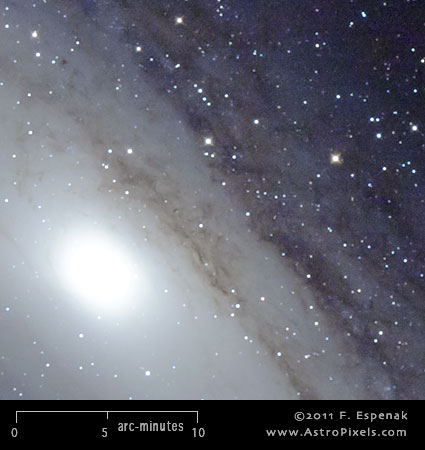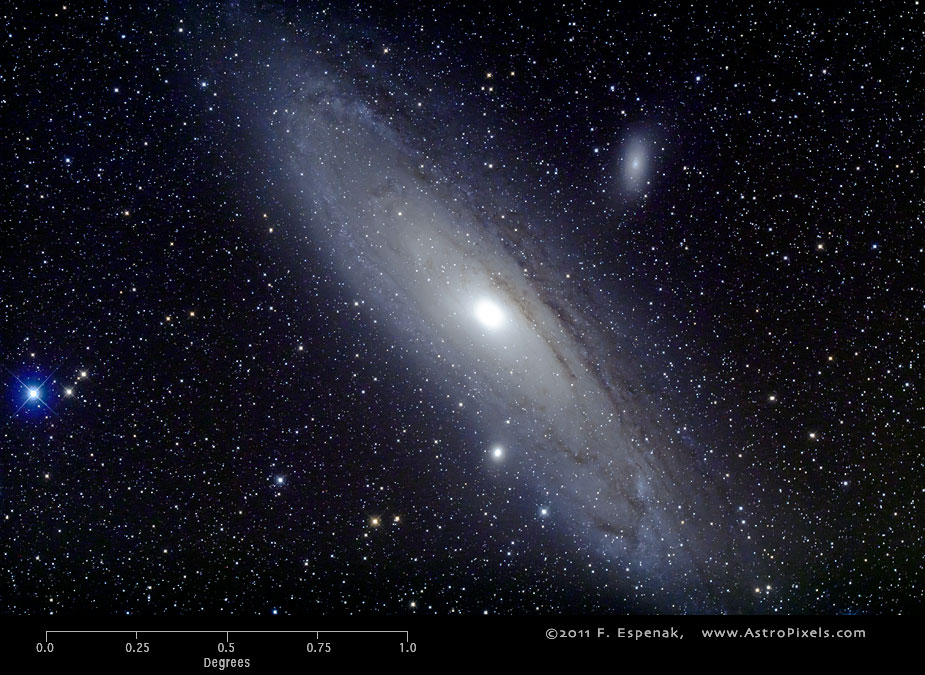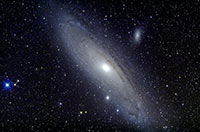
M31 - Andromeda Galaxy
Messier 31 or M31 (also designated NGC 224) is a spiral galaxy in the constellation Andromeda. It has an apparent visual magnitude of 3.4 and its angular diameter is 178x63 arc-minutes. M31 lies at an estimated distance of 2.9 million light years. The Equinox 2000 coordinates are RA= 0h 41.8m, Dec= +41° 16´ which makes M31 best seen during the autumn. The Messier Autumn Star Chart shows the position of all Messier objects visible during that season. As one of the more famous objects in the Messier Catalog, it is commonly known as the Andromeda Galaxy.
The image above shows the uncropped view of M31, and its satellite galaxies M32 and M110 through the Takahashi E-180 Astrograph (North is up). A 3x enlargement of this image centered on M32 appears to the right.
Although it is included in the Messier Catalog, this spiral galaxy was actually discovered by Persian astronomer Al Sufi in 964. For any years, it was believed to be a nearby nebula. It wasn't until 1923 that Edwin Hubble established the intergalactic distance and the true nature of M31 as a galaxy. According to Stoyan et al. (2010), the distance of M31 is 2.57 million light years and its diameter is 157,000 light years. Its estimated mass is 300-400 billion solar masses.
The Great Andromeda Galaxy is the brightest naked-eye spiral galaxy. M31 has two satellite elliptical galaxies visible in the image above. The closer one (along the lower edge of 'Andromeda') is known as M32 (NGC 221). The more distant elliptical (upper right of 'Andromeda') is M110 (NGC 205). M31, M32 and M110 are part of the Local Group of galaxies which includes our own Milky Way Galaxy, the Triangulum Galaxy (M33) and others.
For more information, see the Messier Catalog as well as specific entries for M31 in Wikipedia and SEDS.
Messier's Description of M31
August 3, 1764
`The beautiful nebula of the belt of Andromeda, shaped like a spindle;
M. Messier has investigated it with different instruments, and he didn't
recognise a star: it resembles two cones or pyramids of light, opposed at
their bases, the axes of which are in direction NW-SE; the two points of light
or the apices are about 40 arc-minutes apart; the common base of the pyramids
is about 15'. This nebula was discovered by Simon Marius, and
consequently observed by different astronomers. M. le Gentil has given a
drawing in the Memoirs of the Academy for 1759, page 453.
It is reported on the English Atlas Coelestis.'
(diam. 40')
Flammarion reports that Messier added a note in his personal copy of the catalog by hand: `I have employed different instruments, especially an excellent Gregorian telescope of 30 feet FL, the large mirror 6 inches in diameter, magnification 104x. The center of this nebula appears fairly clear in this instrument without any stars appearing. The light gradually diminishes until it becomes extinguished. The former measurements were made with a Newtonian telescope of 4.5 feet FL, provided with a silk thread micrometer. Diameter 40'. August 3, 1764.')
Technical Details
- Object: M31
- Other Names: NGC 224, Andromeda Galaxy
- Object Type: spiral galaxy
- Object Data: Apparent Magnitude = 3.4, Angular Size = 178x63 arc-minutes
- Object Position (Equinox 2000): RA= 0h 41.8m, Dec= +41° 16´, Constellation = Andromeda
- Date/Time: 2011 Jan 23 at 03:25 UTC
- Location: Bifrost Astronomical Observatory, Portal, AZ
- Mount: Astro-Physics 1200GTO
- Telescope: Takahashi Epsilon 180 Hyperbolic Astrograph
- Camera: Canon EOS 550D (Rebel T2i) (modified with a Baader UV/IR filter)
- Field of View: 1.70° x 2.56° at 1.7 arc-sec/pixel (web version: 10.0 arc-sec/pixel)
- Exposure: 8 x 300s, f/2.8, ISO 800
- File Name: M31-01w.jpg
- Processing (Adobe Camera Raw): Graduated Filter, Vignetting Correction, Noise Reduction, White Balance, Curves
- Processing (Photoshop CS5): Average Images, Curves, Noise Reduction
- Original Image Size: 3454 × 5179 pixels (17.9 MP); 11.5" x 17.3" @ 300 dpi
- Rights: Copyright 2011 by Fred Espenak. All Rights Reserved. See: Image Licensing.




